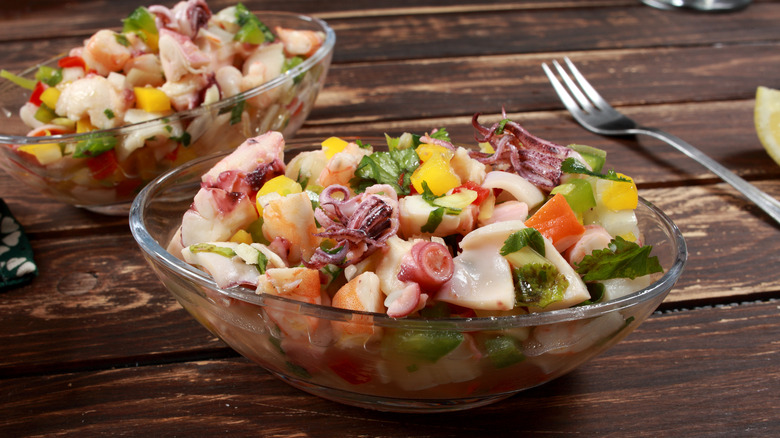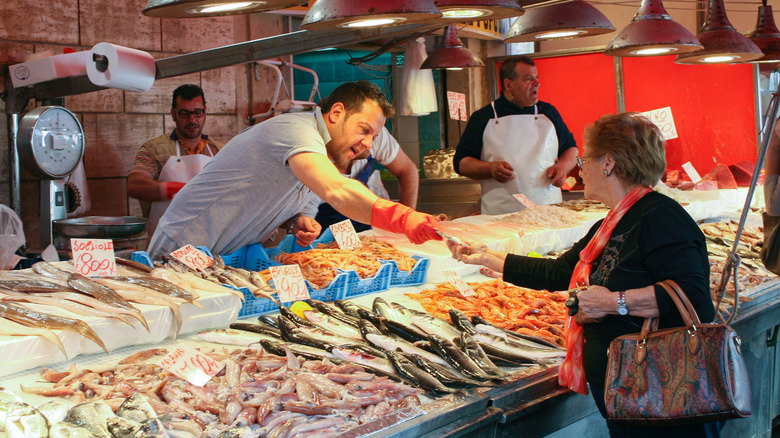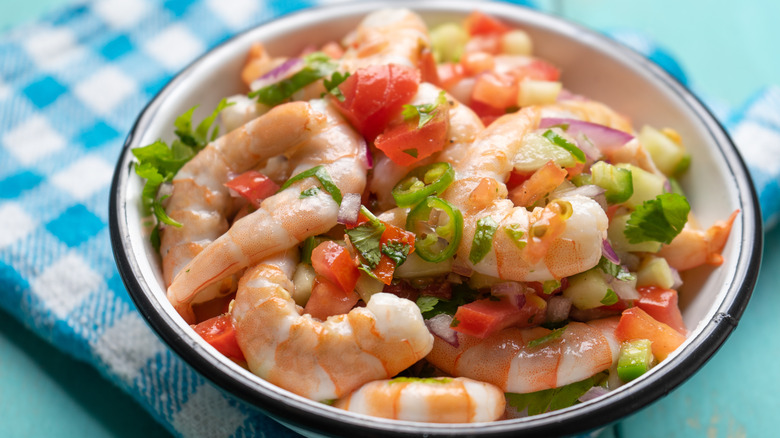What Are The Best Types Of Fish For Ceviche?
We may receive a commission on purchases made from links.
Ceviche is one of those dishes that grips the senses. It's bracing in the best ways possible — cold and evocative of the seaside with an almost electrifying citrus ting. Texturally, ceviche is a symphony of yielding fish against the crunch of fresh vegetables. For some, the first bite transports the mind to coastal Peru, where the dish originated. In fact, according to the Washington Post, the name ceviche is possibly rooted in the Quechua word "siwichi" meaning "fresh fish," though it also may be derived from the Spanish escabeche, which refers to a dish of meat, fish, or vegetables allowed to marinate and cook in flavored vinegar, notes Epicurious.
A cursory search of the internet turns up seemingly endless variations of ceviche, with none of them claiming to be the original recipe. That's as it should be; ceviche is a preparation, not a fixed dish. The New Peruvian outlines 11 different types, ranging from a traditional fish ceviche to variations using mushrooms, beans, and even bull "oysters" instead of seafood. Further, ceviche is found throughout Latin America and across the globe, with recipes calling for octopus, halibut, celery, and ginger (via Wine Enthusiast.)
With so much variety, it can be hard to know where to start and what to buy. A proper fishmonger's case is a bounty of seafood, but which provides the best base for ceviche?
Which fish?
If you're unfamiliar with ceviche — also sometimes spelled seviche — then here's a quick primer. Seafood, from fish to shellfish, is marinated in a strongly acidic liquid, typically a citrus juice, and usually vegetables, with onions and chiles being among the most common. The acidic marinade acts quickly to denature the proteins in the meat, giving it the hallmarks of being cooked with heat while retaining the brightness of raw fish (via Serious Eats).
The best place to get started when working ceviche into your repertoire is with a basic, yet refined recipe. Eating Well offers one that gives the cook a little discretion when it comes to the choice of fish. They recommend selecting a white fish with firm flesh, offering up mahi-mahi or cod as suggestions. This type of fish proves resilient enough to stand up to the action of the marinade while not being so assertive as to dominate the dish's overall flavor profile. One of the most important things to remember, regardless of what seafood you choose, is to pick only the freshest, which not only provides optimal flavor, but also minimizes the risk of exposure to food-borne pathogens.
Explore the bounty of the sea
Once comfortable in your ceviche game, you may want to venture outside of traditional recipes and tackle one of the multitude of ceviche variations that make use of nontraditional seafood and flavoring combinations.
If you're a fan of shrimp, you'll want to try this Mexican ceviche from My Latina Table. It packs in flavor — and spice — with a healthy dose of hot sauce and fresh jalapeños, balancing it with rich and creamy chunks of avocado.
Another great shellfish to use in ceviche is the scallop. In this adaptation of a recipe from Martin Morales' book "Ceviche: Peruvian Kitchen," the tender flesh of the bivalve is dressed with lime juice, dotted with crunchy, tart pomegranate seeds, and drizzled with Peru's most famous liquor, Pisco.
No matter the recipe — or recipes — you choose to explore, there is one ceviche adjacent food stuff that is not to be missed. Leche de Tigre, which translates to "tiger's milk," is the piquant juice left over after ceviche has marinated. It is commonly consumed as a beverage, either alongside ceviche or on its own as a prized hangover cure, explains Food & Wine.


